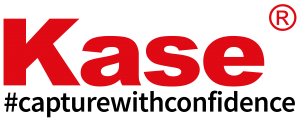August 26, 2020
Seascape Workshop – dodging the rain
It was great to be back running the Landscape and Seascape Workshop this weekend. Read on to find how we have made it COVID secure and avoided the rain!

When we look back on 2020, quite a lot of businesses will have found new ways of doing things as a result of the COVID crisis. We introduced online alternatives during the lockdown, which proved popular. I am getting great feedback already that having a video call before the Switch to Manual Workshop works much better than sitting in a coffee shop going through the theory of taking photos. However, the Landscape and Seascape workshop was going to be much more challenging to make COVID secure as it is very practical and involves travelling in vehicles.
As with all our workshops, we developed a plan when the Scottish Government released the “COVID-19: Framework for Decision Making – Scotland’s route map through and out of the crisis”. We had the plan reviewed by Business Gateway, who confirmed that our processes did meet the government guidelines. As the Government has re-evaluated the phases every three weeks, we continue to ensure our procedures keep us COVID secure. So, last weekend we were finally able to put our plans to the test as we ran our first Landscape and Seascape workshop with a group of eager photographers.
COVID changes
Many of the changes we have made to the workshop are common sense. We will change the size of the vehicle we use to move clients from location to location depending on the group size. If we have a group of two, then we will use a car, and every passenger must wear a face-mask whilst in the car, which is kept well ventilated. For larger groups, we hire a mini-bus, so we can ensure there is distancing as we move around the locations.
When we arrive at locations, we ask that everyone not in family groups conforms with physical distancing rules by maintaining two metres. As all the sites are outdoors and in the landscape, this is quite easy to do.
One of the fundamental values I made front and centre of Edinburgh Photography Workshop when I started the business was that I would strive to give clients the experience that they wanted by being flexible. I have stuck by this ethos for seven years of trading. Two of the attendees on the workshop preferred to travel in their vehicle rather than share with the group. I was happy to go along with this; if they felt safe and could still enjoy the workshop, then I was delighted.
What we can’t control
I’ve always lived by the maxim, “Don’t worry about the things you can’t control and focus your energies on the things you can”. You can see I apply this to the measures that I have put in place for COVID. I also plan the route for the workshop in advance to ensure the conditions will be as good as they can be for my clients. A few days before the session, I’ll check various weather forecasts so that we aren’t spending all day getting soaked by the driving rain. Even the night before the workshop, we were looking at a mainly dry day with the occasional shower. I didn’t expect the torrential downpour we experienced in the middle part of the day, nor the inability of the weather apps to be able to predict what would happen just an hour ahead!
The good thing for my clients is that I still try and have a plan B, just in case we have to divert and so it was with this workshop as I delved into the locations I have got to know to try and dodge the rain and get some great shots for my clients.
Seascape workshop locations in Fife
2020 is the first year that we are running the Landscape and Seascape Workshop in the summer months. It’s usually a sunrise to sunset workshop and Scotland’s 17 hour days would be far too long in summer. Instead, we’ll try and capture either a sunrise or a sunset and retain the workshop length around 12 to 13 hours. (Quite a bargain for £150 each!)
This time, we started a little later with a relaxed 7 AM pick up in Edinburgh before travelling to St Monans in Fife. It is one of many pretty fishing villages on the East Neuk and is a favourite for photographers. Mostly because of the breakwater pier which zig-zags out into the Forth. It’s easy to leave once you’ve got the famous shot in the bag, but stick around and look for some other views around the village. You can look westwards toward the church perched on the coastline or eastwards to the sail-less windmill above the salt-flats.

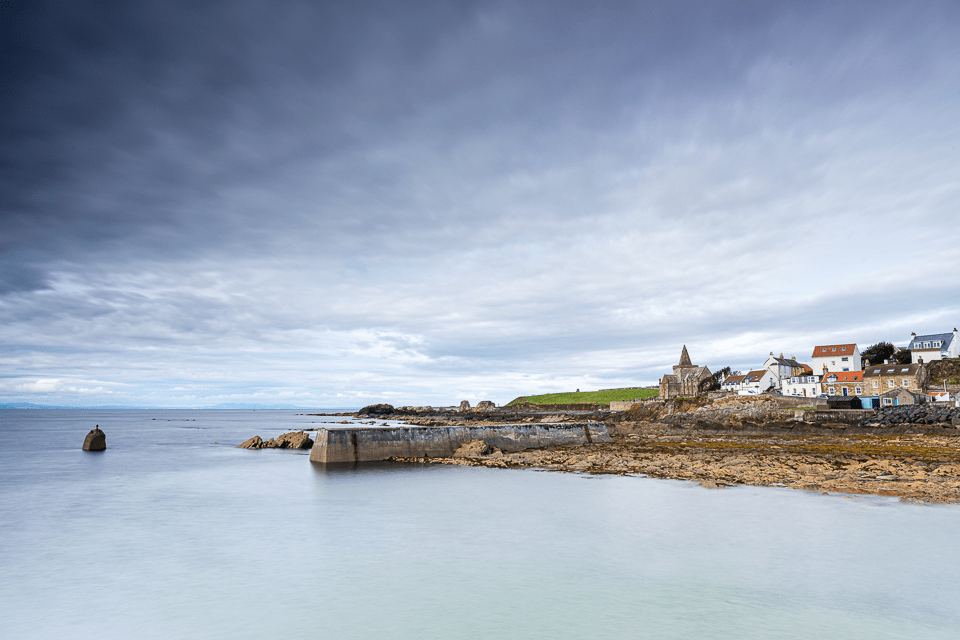
Next, we headed a few miles along the coast to Elie where we have the Elie Ness Lighthouse and Lady’s Tower. It’s fun to relive a childhood spent wandering over rock pools and then getting back into the photography zone to take reflections of the lighthouse in the ponds. Carry on along to the Lady Anstruther’s Tower to photograph the ancient changing facility on the cliff top which allowed the lady, from which the tower takes its name, to get ready before bathing in the waters below.
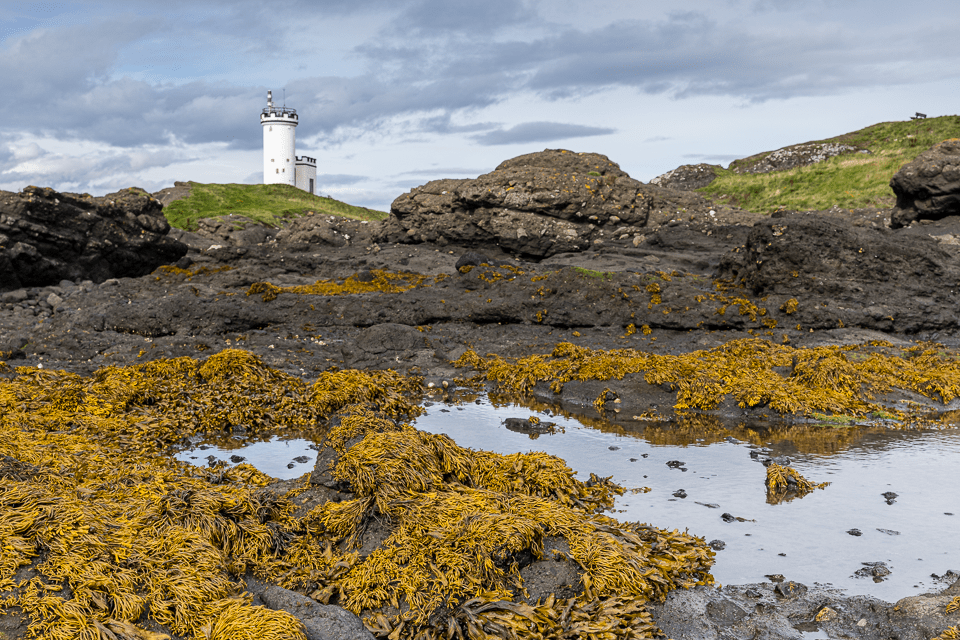
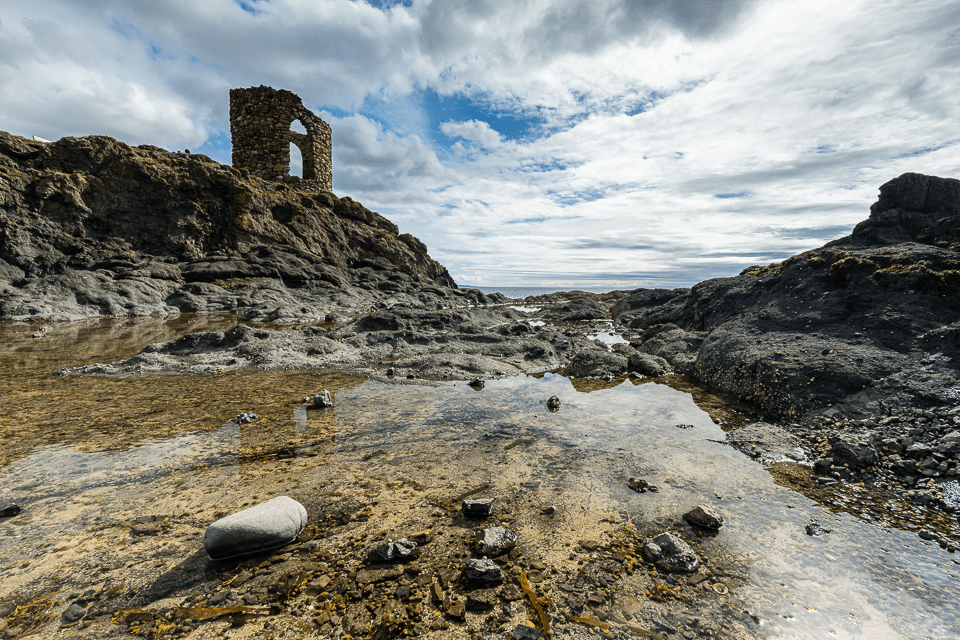
Rain dodging
So far the weather had been with us. As we headed south over the Queensferry Crossing and back onto the Edinburgh side of the Forth, we encountered much more rain than had been forecast. An early lunch while the rain died down a little, then a dash to the end of the pier in Port Edgar to capture some panoramas of the three bridges. Thankfully, we had a couple of umbrellas to help keep the drizzle off the lenses. I used the most substantial part of the rainfall to show how to process the pano shots in Lightroom. It’s amazing how the back shelf of a 4×4 can convert to a travelling classroom!

The short-trip through South Queensferry took us to a viewpoint of the Forth Bridge (often, incorrectly called the Forth Rail Bridge). When we have poor conditions of flat grey skies and rain, it’s worth ditching the planned shot and changing the way to shoot. A close up of a section of the bridge with a bit of post-processing gives a very commercial looking photograph.

Our final damp location took us to the Cramond Causeway. The wet weather hadn’t stopped tourists walking over to the island. However, the sky was still mostly grey, so it was challenging to find shots. I find in these conditions that it is best to think in monochrome and look for interesting contrasts. The line of water in the pools in front of the monolithic blocks does the job.
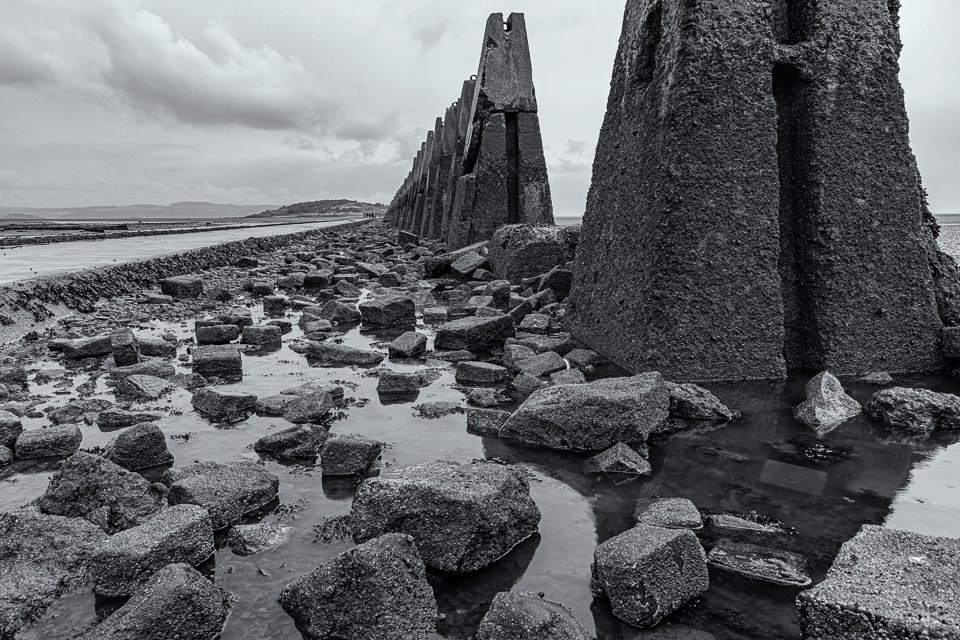
Light on the horizon
After a few hours of poor weather, I thought it would be best to divert from the planned route. A longer drive to Portobello Beach bought enough time for the rainclouds to clear (even though the apps were telling us that we’d be having rain for the rest of the day). The groynes on the beach provide an opportunity to practice using different ND filters. Varying the shutter speeds to blur the movement in the waves gave some pleasing results and taught a valuable lesson. Not all water movement shots need to flatten the water; it’s good to see a bit of the detail in the waves to show that the tide is coming in.
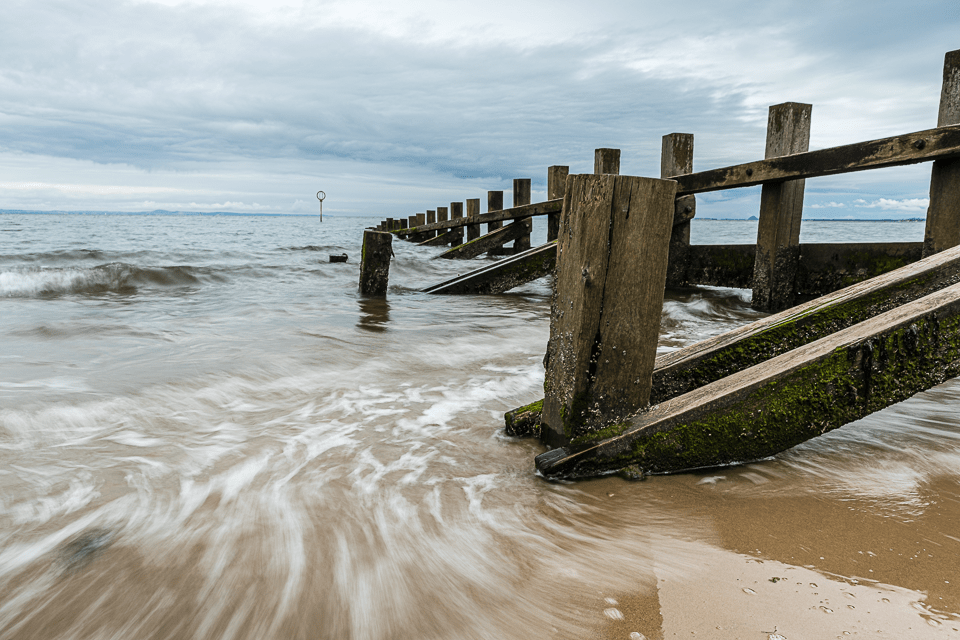
As we had a bit of time spare by not spending as long at the Forth Bridge locations, I could add in a couple of landscape locations. I had visited Preston Mill and the Phantassie Doocot a few days earlier for a project I am working on. It was fascinating to see how a scene can change in just a few days. The fields were knee-high in barley 48 hours earlier. In the interim, the combine harvester had been in the area, and it helped to be able to see the dovecot a little more.
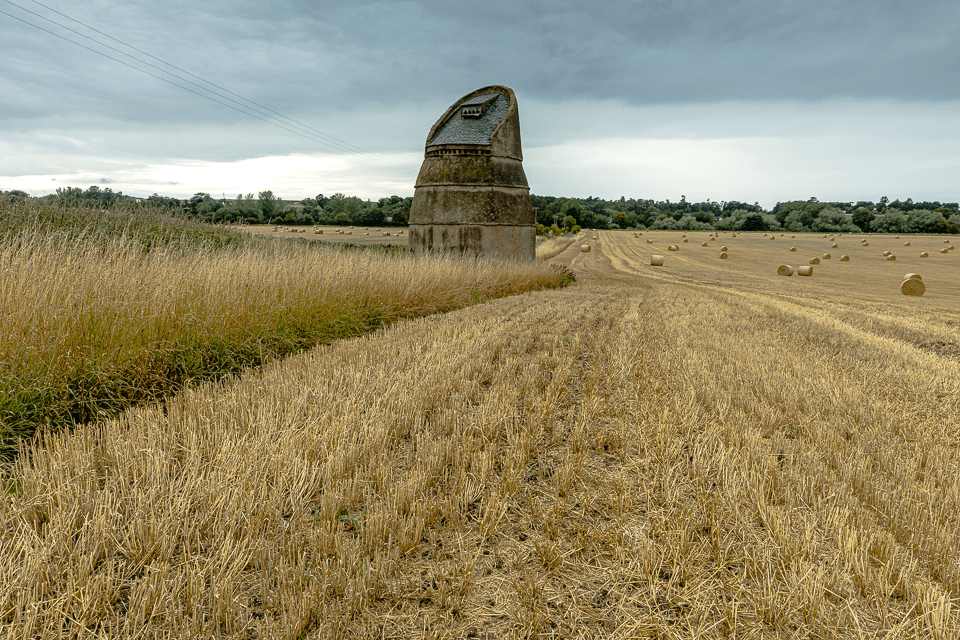
I had timed the workshop so that we’d arrive at Belhaven Bay in time for the high-tide. A 5.1-meter swell meant that it would definitely be a bridge to nowhere with both sides of the bridge covered in water. Putting a long lens on gave the effect of bringing the bridge and the Bass Rock close together and adding 13 stops of Kase ND filters gave a 4-minute exposure that captured the disappearing black clouds perfectly! I love that my filters don’t apply any kind of colour tint, even at particularly long exposures. I have used other (more expensive) systems in the past, and I would need to be applying colour correction in post-processing to get rid of an annoying blue tint.

Almost 12 hours after starting the workshop, we had a decision to make. The sky was still overcast. We could fit in one more location, which was where we’d get the sunsetting. It seemed unlikely, so there was chat amongst the group to have an earlier finish. I’d spotted a tiny break in the clouds in the distance, and it looked like it was in the direction of North Berwick. I suggested that we could take a drive past the Old Pier location as it was on the way back to Edinburgh anyway (kind of).
Driving into North Berwick, expectations peaked a little as we saw the odd bit of colour in the water. By the time we were parked up, it was clear that the gap in the clouds was perfectly placed. Setting up tripods on the Old Pier, we witnessed a spectacular sunset with sunbursts emanating around the clouds. The rocks we stood on, transformed by bright red, almost volcanic looking light. The few minutes it lasted was spectacular. When you get unexpected results like this and seeing the pleasure on my clients’ faces, it makes my job one of the best in the world!
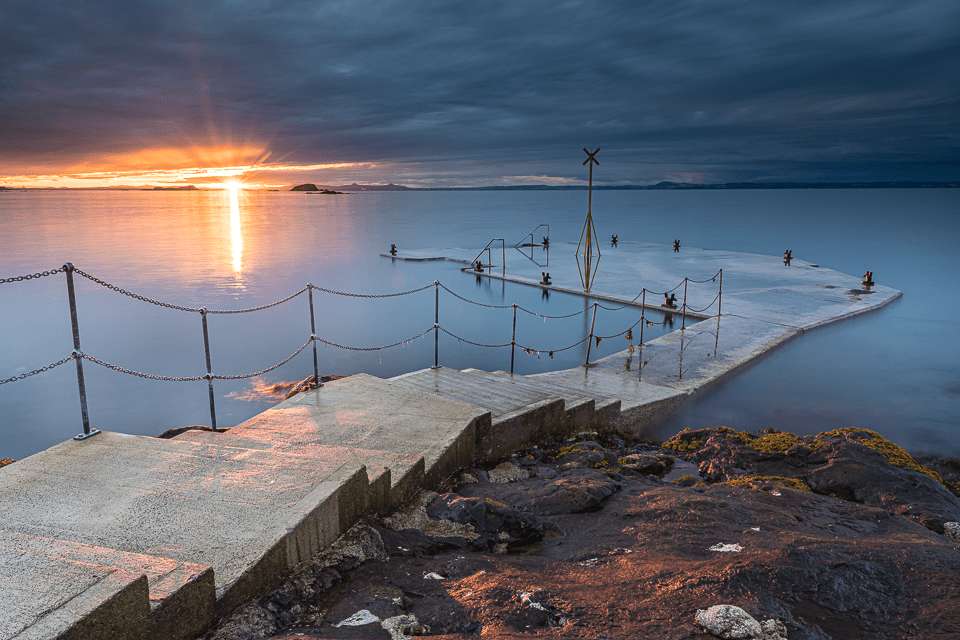
Don’t take my word for it
After the workshop, I asked one of the attendees, Gareth, to give a few thoughts on the day. I’ll share with you his comments.
“Hello, I did the landscape and seascape workshop with Rich Dyson a few days ago, and there were no worries with social distancing. We were able to go to locations, take great shots and still be close enough to Rich to get the instruction we would need and any help and guidance to get the best shot. We had great weather in the morning, but I would say that the weather deteriorated for the afternoon, but stick with it. I ended up with some of the best shots of a sunset I have ever taken by going to one of the locations with Rich and getting his guidance. I think apart from the technical aspect, and learning of all the new bits in the camera one, of the greatest things was finding out new places to take a picture. I’ve lived here for almost ten years, and some of the places I’ve never heard of and have never seen and some of them were quite spectacular. I would highly recommend the course, and I can’t thank Rich enough.”
I’d like to thank Gareth for such a great review of what could have been challenging conditions. He’s kindly agreed to share one of the photos he took at the final location. I’m sure you’ll agree that it is an excellent shot.
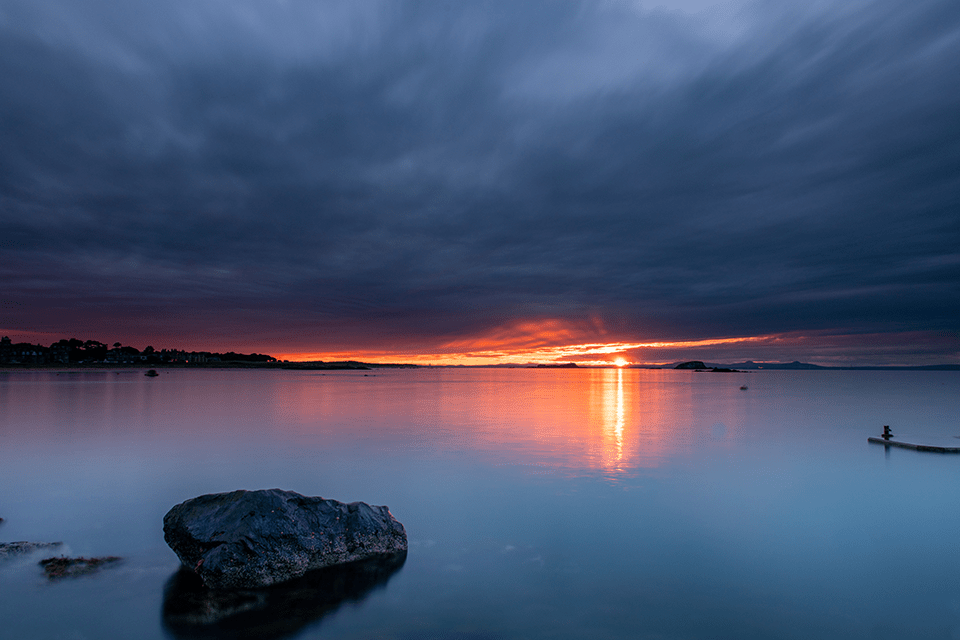
Listen along
If you don’t feel like spending time reading these blogs, you can now listen to them instead. Head to your usual podcast providers such as iTunes or Google podcasts and search for The Edinburgh Photography Workshop Podcast. If you do like listening, please subscribe to hear it every week and leave a review. That helps others to find the podcast as well.
Give us your feedback
If you’ve got any questions or comments, leave them below. You can sign up for the Edinburgh Photography Workshop monthly newsletter where you’ll’ get regular updates on exciting things happening in photography and some great tips. Sign up by clicking here.